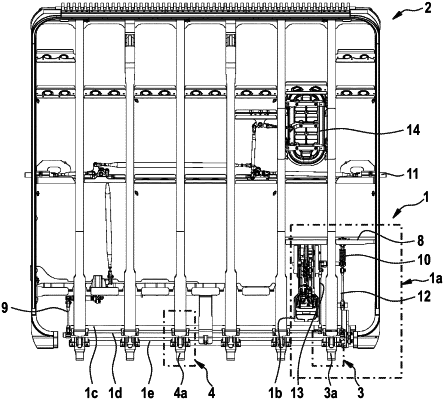| CPC B64C 1/1461 (2013.01) [E05B 79/12 (2013.01); E05C 9/08 (2013.01); E05C 9/1891 (2013.01); E05C 19/002 (2013.01); E05C 19/10 (2013.01); E05Y 2900/502 (2013.01); Y10T 292/0828 (2015.04); Y10T 292/0829 (2015.04); Y10T 292/0853 (2015.04); Y10T 292/0911 (2015.04); Y10T 292/0945 (2015.04); Y10T 292/0947 (2015.04); Y10T 292/0952 (2015.04)] | 20 Claims |

|
1. An actuating system for an actuatable door, the actuating system comprising:
a first rotatable latching shaft;
a second rotatable latching shaft;
a coupling link;
a first pivotable mechanical transmission element, that is mounted onto the first rotatable latching shaft;
a second pivotable mechanical transmission element, that is fixedly mounted onto the second rotatable latching shaft, and that is connected to the first pivotable mechanical transmission element via the coupling link, a first end of the coupling link being pivotally mounted to the first pivotable mechanical transmission element and a second end of the coupling link being pivotally mounted to the second pivotable mechanical transmission element, such that rotation of the first rotatable latching shaft in operation upon actuation results in pivoting of the first pivotable mechanical transmission element, pivoting of the second mechanical transmission element, and rotation of the second rotatable latching shaft;
a first latching member and a second latching member that are non-rotatably mounted to the second rotatable latching shaft and adapted for latching the actuatable door in a closed position, wherein the rotation of the second rotatable latching shaft causes rotation of the first and second latching members around an axis defined by the second rotatable latching shaft; and
a first latch securing device and a second latch securing device are fixedly mounted to the first rotatable latching shaft to a securing position preventing the rotation of the first and second latching members when the first and second latching members latch the actuatable door in the closed position,
wherein the rotation of the first rotatable latching shaft from the securing position preventing the rotation of the first and second latching members causes rotation of the first and second latch securing devices around an additional axis defined by the first rotatable latching shaft.
|